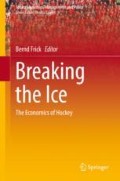Abstract
Research in labor economics has examined many determinants of earnings, including whether an individual is left or right handed. Sports economists have recently shown that in the soccer labor market, being able to kick well with both the left and the right foot is rewarded with a salary premium. This paper examines pay and performance for hockey players that shoot left-handed versus those that shoot right-handed. We find that after controlling for goals and assists, time on the ice, player size and age, and team and season fixed effects, players are paid differently by position, and players playing the same position may be paid differently because they shoot left versus right handed. These results suggest that the hockey player labor market is inefficient.
Access this chapter
Tax calculation will be finalised at checkout
Purchases are for personal use only
Notes
- 1.
Estimates of left-handedness vary from about 10% to 30%, with the proportion apparently on the rise. In the NHL, 65% of players shoot left-handed. In the Elitserien the proportion is 79%.
- 2.
Mason and Foster (2007) discuss the possibilities of “Moneyball on Ice”, that is, that there is some player input into winning hockey that the hockey world incorrectly values, but all the possibilities discussed involve highly complex data collection and analysis. The beauty and power of the Moneyball hypothesis is that the mispriced attribute was easily observable.
- 3.
Little changes if the body mass index and BMI squared replace the height and weight variables.
References
Altonji, J.G. and R.M. Blank (1999): Race and Gender in the Labor Market, in: Handbook of Labor Economics, Volume 3c. Amsterdam, New York, and Oxford: Elsevier Science, North Holland.
Annett, M. and M. Manning (1989): The Disadvantages of Dextrality for Intelligence. British Journal of Psychology, 80, pp. 213–226.
Benbow, C. (1986): Physiological Correlates of Extreme Intellectual Precocity. Neuropsychologia, 24, pp. 719–725.
Biddle, J.E. and D.S. Hamermesh (1994): Beauty and the Labor Market. American Economic Review, 84, pp. 1174–1194.
Bradbury, J.C. (2006a): Do Southpaws get a fair shake in MLB? http://www.sabernomics.com/sabernomics/index.php/2006/08/do-southpaws-get-a-fair-shake-in-mlb/
Bradbury, J.C. (2006b): Do Southpaws get a fair shake in MLB? Part 2: pitchers” http://www.sabernomics.com/sabernomics/index.php/2006/08/do-southpaws-get-a-fair-shake-in-mlb-part-2-pitchers/
Bryson, A., B. Frick, and R. Simmons (2013): The Returns to Scarce Talent: Footedness and Player Remuneration in European Soccer. Journal of Sports Economics, 14, pp. 606–628.
Coates, D., M. Battre and C. Deutscher (2011): Does Violence Pay in Professional Hockey?: Cross Country Evidence from Three Leagues, in Violence and Aggression in Sporting Contests, R. Todd Jewell, editor, Springer: New York.
Coren, S. (1995): Differences in Divergent Thinking as a Function of Handedness and Sex. American Journal of Psychology, 108, pp. 311–325.
Denny, K. and V. O’Sullivan (2007): The Economic Consequences of Being Left-Handed: Some Sinister Results. Journal of Human Resources, 42, pp. 353–374.
Heineck, G. (2005): Up in the Skies? The Relationship between Body Height and Earnings in Germany, Labour, 19, pp. 469–489.
Hicks, R. and C. Dusek (1980): The Handedness Distributions of Gifted and Non-Gifted Children. Cortex, 16, pp. 479–481.
Idson, T. and L. Kahane (2000): Team Effects on Compensation: An Application to Salary Determination in the National Hockey League. Economic Inquiry, 38, pp. 345–357.
Jones, J.C.H. and W.D. Walsh (1988): Salary Determination in the National Hockey League: The Effects of Skills, Franchise Characteristics, and Discrimination. Industrial and Labor Relations Review, 41, pp. 592–604.
Jones, J.C.H., S. Nadeau and W.D. Walsh (1997): The Wages of Sin: Employment and Salary Effects of Violence. Atlantic Economic Journal, 25, pp. 191–206.
Jones, J.C.H., S. Nadeau and W.D. Walsh (1999): Ethnicity, Productivity and Salary: Player Compensation and Discrimination in the National Hockey League. Applied Economics, 31, pp. 593–608.
Kahane, L., N. Longley and R. Simmons (2013): The Effects of Coworker Heterogeneity on Firm-Level Output: Assessing the Impacts of Cultural and Language Diversity in the National Hockey League. Review of Economics and Statistics, 95, pp. 302–314.
Lambrinos, J. and T.D. Ashman (2007): Salary Determination in the NHL: Is Arbitration Efficient? Journal of Sports Economics, 8, pp. 192–201.
Lavoie, M. (2000): The Location of Pay Discrimination in the National Hockey League. Journal of Sports Economics, 1, pp. 401–11.
Longley, N. (1995): Salary Discrimination in the National Hockey League: The Effects of Team Location. Canadian Public Policy, 21, pp. 413–22.
Lewis, M. (2003): Moneyball: The Art of Winning an Unfair Game. New York: W.W. Norton and Company.
Mason, D.S. and W.M. Foster (2007): Putting Moneyball on Ice. International Journal of Sport Finance, 2, pp. 206–213.
McLean, R.C. and M.R. Veall (1992): Performance and Salary Differentials in the National Hockey League. Canadian Public Policy, 18, pp. 470–475.
Reubeck, C.S., J.E. Harrington, Jr. and R. Moffitt (2007): Handedness and Earnings. Laterality, 12, pp. 101–120.
Richardson, D. (2000): Pay, Performance, and Competitive Balance in the National Hockey League. Eastern Economic Journal, 26, pp. 393–417.
Scully, G. (1974): Pay and Performance in Major League Baseball. American Economic Review, 64, pp. 915–930.
Author information
Authors and Affiliations
Corresponding author
Editor information
Editors and Affiliations
Rights and permissions
Copyright information
© 2017 Springer International Publishing AG
About this chapter
Cite this chapter
Coates, D. (2017). Returns to Handedness in Professional Hockey. In: Frick, B. (eds) Breaking the Ice. Sports Economics, Management and Policy, vol 16. Springer, Cham. https://doi.org/10.1007/978-3-319-67922-8_3
Download citation
DOI: https://doi.org/10.1007/978-3-319-67922-8_3
Published:
Publisher Name: Springer, Cham
Print ISBN: 978-3-319-67921-1
Online ISBN: 978-3-319-67922-8
eBook Packages: Economics and FinanceEconomics and Finance (R0)

